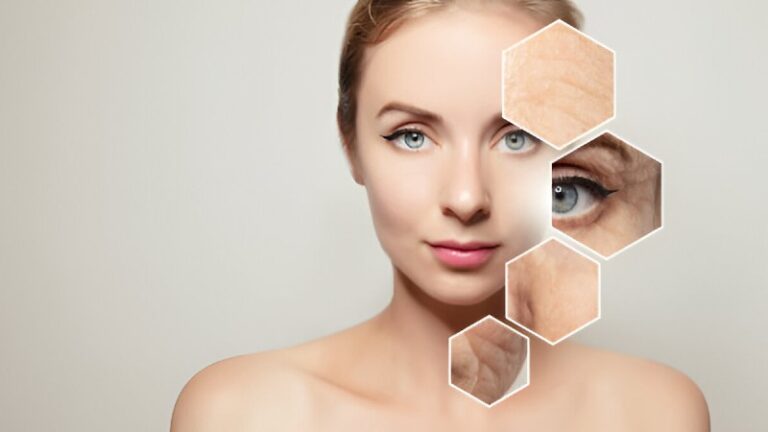Anti-aging skincare is more than a beauty trend it’s a science. As we age, our skin undergoes natural changes like decreased collagen, reduced elasticity, and slower cell turnover. These changes manifest as fine lines, wrinkles, sagging, and uneven skin tone. While the skincare aisle is flooded with countless products, understanding the science behind key anti-aging ingredients can help you make informed choices that actually work.
Understanding the Biology of Aging Skin
Before diving into ingredients, it’s essential to understand what happens to the skin over time:
- Collagen Decline: Collagen provides structure and firmness. Production decreases by 1% per year after the age of 25.
- Elastin Reduction: Elastin allows skin to return to its original shape. Reduced elastin leads to sagging.
- Thinning Epidermis: The outer skin layer becomes more delicate and prone to damage.
- Moisture Loss: Natural hyaluronic acid decreases, causing dryness and dullness.
- Oxidative Stress: Free radicals from UV exposure, pollution, and lifestyle choices damage skin cells and accelerate aging.
Both intrinsic (genetics) and extrinsic (environmental) factors contribute to aging, making a multi-faceted approach essential.
Key Anti-Aging Ingredients and How They Work
Science-backed ingredients target aging mechanisms at the cellular level. Let’s explore the most effective ones:
1. Retinoids (Vitamin A Derivatives)
Retinoids are among the most researched anti-aging ingredients. They work by:
- Stimulating collagen production
- Increasing cell turnover
- Reducing fine lines, wrinkles, and hyperpigmentation
Example: Retinol serums can be used nightly to gradually improve skin texture. Prescription-strength tretinoin is more potent but may require dermatologist supervision.
2. Vitamin C (Ascorbic Acid)
Vitamin C is a powerful antioxidant that neutralizes free radicals, preventing oxidative damage. It also supports collagen synthesis and brightens the skin.
- Reduces dark spots and hyperpigmentation
- Improves skin radiance and tone
- Enhances wound healing and skin repair
Tip: Use vitamin C in opaque containers to prevent degradation from light exposure. Concentrations between 10–20% are most effective.
3. Hyaluronic Acid (HA)
Hyaluronic acid is a humectant that retains moisture, plumping the skin and smoothing fine lines.
- Improves skin elasticity
- Provides immediate hydration boost
- Can be layered with other anti-aging products
Example: A morning serum containing HA can enhance the effectiveness of sunscreen by keeping the skin hydrated.
4. Peptides
Peptides are short amino acid chains that signal skin to produce collagen and elastin.
- Promote skin firmness and elasticity
- Reduce wrinkles and sagging
- Enhance the efficacy of moisturizers and serums
Example: Copper peptides are commonly used in nighttime creams to support skin repair during sleep.
5. Niacinamide (Vitamin B3)
Niacinamide targets uneven skin tone and inflammation. Research shows that topical niacinamide can:
- Reduce hyperpigmentation and sunspots
- Improve skin redness and sallowness
- Strengthen the skin barrier
Example: A 5% niacinamide serum applied twice daily can even skin tone in as little as four weeks.
6. Alpha-Hydroxy Acids (AHAs)
AHAs, such as glycolic acid and lactic acid, exfoliate the top layer of the skin, promoting smoother and brighter skin.
- Improves roughness and dullness
- Reduces fine lines and hyperpigmentation
- Enhances penetration of other skincare ingredients
Example: Over-the-counter glycolic acid toners (around 10%) can deliver visible results safely at home.
Sun Protection
While active ingredients are crucial, sunscreen remains the single most effective anti-aging product. UV rays accelerate collagen breakdown, cause pigmentation, and increase the risk of skin cancer.
- Use broad-spectrum SPF 30 or higher daily
- Apply even on cloudy days or indoors near windows
- Reapply every two hours if exposed to sunlight
Statistic: Studies show that regular sunscreen use can reduce photoaging by up to 24% over four years.
Combining Ingredients
Some ingredients work best when paired strategically. Here’s a table summarizing complementary combinations:
| Ingredient | Best Pairings | Effect |
|---|---|---|
| Retinoids | Moisturizer, Niacinamide | Reduces irritation while boosting collagen |
| Vitamin C | Vitamin E, Ferulic Acid | Enhances antioxidant stability and brightening |
| Hyaluronic Acid | Peptides, Vitamin C | Improves hydration and product penetration |
| AHAs | Vitamin C (alternate days) | Promotes smoother skin and better absorption of antioxidants |
Examples of Science-Backed Anti-Aging Routines
Morning Routine
- Gentle cleanser
- Vitamin C serum
- Hyaluronic acid serum (optional for dry skin)
- Moisturizer
- Sunscreen SPF 30+
Evening Routine
- Gentle cleanser
- Retinol or peptide serum
- Moisturizer
- Niacinamide serum (if targeting pigmentation)
Tip: Introduce new actives gradually to avoid irritation. Allow 8–12 weeks to see visible results.
Lifestyle Factors That Influence Aging
Science shows that lifestyle significantly impacts skin aging. Effective anti-aging strategies include:
- Balanced diet rich in antioxidants, healthy fats, and protein
- Regular exercise to improve circulation
- Quality sleep to support skin repair
- Stress management to reduce cortisol-related skin damage
- Limiting alcohol and tobacco, which accelerate oxidative stress
Anti-Aging Ingredients at the Cellular Level
Emerging research highlights that anti-aging ingredients don’t just improve surface appearance—they influence cellular processes:
- Epigenetic Modulation: Certain antioxidants and peptides can influence gene expression to favor skin repair and collagen synthesis.
- Senescent Cell Reduction: Retinoids and niacinamide may help reduce the accumulation of aged cells that slow skin regeneration.
- Mitochondrial Support: Antioxidants like vitamin C and resveratrol protect mitochondria in skin cells, improving energy production and resilience.
By targeting skin at the cellular and molecular level, these ingredients go beyond superficial improvements, promoting long-term skin health.
Conclusion
Understanding the science behind anti-aging ingredients allows for informed choices that yield real results. Key takeaways include:
- Retinoids, vitamin C, peptides, hyaluronic acid, niacinamide, and AHAs are scientifically proven to improve skin texture, firmness, and tone.
- Sun protection remains the most critical anti-aging step.
- Combining ingredients strategically maximizes effectiveness.
- Consistency, patience, and holistic lifestyle choices enhance results.
- Emerging cellular-level research opens exciting possibilities for next-generation anti-aging solutions.
By focusing on evidence-based ingredients, maintaining sun protection, and supporting your skin with healthy lifestyle habits, you can slow the signs of aging and maintain radiant, youthful skin for years to come.
Frequently Asked Questions
What anti-aging ingredient should I start with first?
Begin with daily broad-spectrum SPF 30+ and a morning vitamin C serum. Add a retinoid 2–3 nights per week, then build to nightly as tolerated. This sequence maximizes protection and supports collagen with minimal irritation.
How long until anti-aging ingredients show results?
Hydration (hyaluronic acid) can look better immediately; tone/brightness (vitamin C/niacinamide) often improves in 4–8 weeks; texture/fine lines from retinoids and AHAs usually need 8–12+ weeks of consistent use.
Can I use vitamin C and retinol together?
Yes—use vitamin C in the morning (antioxidant defense) and retinoids at night (cell turnover). If sensitive, alternate days or buffer retinoids with moisturizer.
Which is better: retinol or prescription tretinoin?
Tretinoin is stronger and works faster, but it can be more irritating. Retinol is OTC, effective with time, and often better tolerated. Choose based on skin sensitivity and access to dermatology guidance.
Where do niacinamide and peptides fit in my routine?
Niacinamide (2–5%) is versatile—AM or PM—to support the barrier and even tone. Peptides pair well with moisturizers, especially at night, to complement collagen support without irritation.
Are AHAs safe to use with retinoids?
They can be, but avoid layering on the same night if you’re sensitive. Try AHAs 1–3 nights/week and retinoids on alternate nights. Always use daily sunscreen.
Do expensive products work better than drugstore options?
Not necessarily. Focus on active ingredients, concentrations, pH, and packaging (e.g., opaque for vitamin C). Many affordable formulas perform as well as premium ones.


